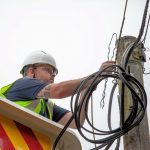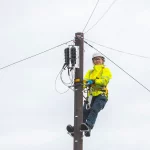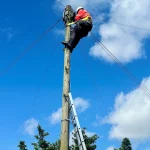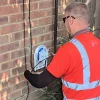BDUK Refine Picture of Gigabit Broadband Notspots in Key UK Cities

The Government’s Building Digital UK agency has published the outcome of last year’s reviews into several key urban areas under their £5bn Project Gigabit broadband rollout, which looked to identify which parts of Greater London, Merseyside and Greater Manchester, Newcastle and Birmingham might be left unserved.
Firstly, the usual recap. Project Gigabit aims to extend networks capable of delivering “gigabit” (1000Mbps) download speeds to “at least” 85% of UK premises by the end of 2025 and then “nationwide” coverage (c.99%) by around 2030 (here). The funding released for this will depend upon how the industry responds, but so far over £2bn worth of procurements and contracts are already in the pipeline (more will follow).
However, last year BDUK signalled a potential future interest in tackling some urban notspots for gigabit coverage too (here), which they did by conducting several Public Reviews (PR) of related coverage across a number of significant urban areas in England. Just for extra context, we recently published an explainer to highlight why it is that some normally lucrative parts of dense urban areas end up being missed out by private builds (here).
Advertisement
The reviews aimed to identify the limitations of planned commercial deployments in each of the aforementioned areas, which tend to designate homes and businesses (premises) as being “Gigabit White” if they aren’t expected to benefit from commercial deployments over the next 3 years.
On top of that, it’s also worth paying attention to the figure for “Under Review” properties, which reflects premises where suppliers have reported planned commercial broadband coverage, but where those plans have been judged as potentially being at risk of not being completed.
Birmingham and the Black Country (Lot 35)
ORIGINAL Details:
The original Open Market Review (OMR) indicated that planned commercial coverage for gigabit-capable broadband would reach approximately 888,945 premises, and would therefore leave the remaining 208,438 premises without access to gigabit-capable broadband.
Final Public Review Details:
Gigabit “White” Premises: 102,035
Under Review Premises: 89,058
ORIGINAL Details:
The original OMR indicated that planned commercial coverage for gigabit-capable broadband would reach approximately 2,632,316 premises, and would therefore leave the remaining 1,704,232 premises without access to gigabit-capable broadband.
Final Public Review Details:
Gigabit “White” Premises: 604,657
Under Review Premises: 549,249
Merseyside and Greater Manchester (Lot 36)
ORIGINAL Details:
The original OMR indicated that planned commercial coverage for gigabit-capable broadband would reach approximately 1,549,670 premises, and would therefore leave the remaining 569,694 premises without access to gigabit-capable broadband.
Final Public Review Details:
Gigabit “White” Premises: 166,380
Under Review Premises: 347,263
Newcastle and North Tyneside (Lot 38)
ORIGINAL Details:
The original OMR indicated that planned commercial coverage for gigabit-capable broadband would reach approximately 184,945 premises, and would therefore leave the remaining 71,441 premises without access to gigabit-capable broadband.
Final Public Review Details:
Gigabit “White” Premises: 5,238
Under Review Premises: 63,361
All of this has helped BDUK to identify the “small pockets of poor urban digital connectivity [that] will remain unserved by the commercial market without government intervention.” But it’s worth noting that the above procurements have recently been removed from Project Gigabit’s pipeline while they ascertain the best approach to use for serving such premises.
The agency is currently engaging the market, councils and other local stakeholders on the most suitable solutions for each of the identified areas. Due to this, we don’t yet know precisely what the plan will be, although clearly there are some big gaps left to fill. But any use of public investment in urban areas like this tends to raise concerns over the use of a potentially anticompetitive market subsidy, which may limit BDUK’s options (this is how we ended up with the original voucher scheme).
Advertisement
Finally, if you’re wondering why there’s no mention of Cardiff (Wales) or Edinburgh (Scotland), then that’s largely because the approach in those countries is still being finalised – due in part to the usual issues of devolved borders and politics.
Mark is a professional technology writer, IT consultant and computer engineer from Dorset (England), he also founded ISPreview in 1999 and enjoys analysing the latest telecoms and broadband developments. Find me on X (Twitter), Mastodon, Facebook, BlueSky, Threads.net and Linkedin.
« Broadband ISP TalkTalk Start FREE Automatic UK FTTP Upgrades























































This highlights the issues with project gigabit well, we’re in Lot 4 were contract should have been signed back in May, but surprise surprise we’re still waiting. Our property should have been picked up by the original BDUk upgrades however BT had marked our property as “In Scope” 3 years & two rounds of funding later they decided to actually get round to doing the survey at which point it was deemed not commercially viable. To add insult to injury they did not release the postcode following the survey which meant we also missed the final round of funding from BDUK. Now we’re a decade further down the line from where we stated & we’re no further forward. The thing that worries me most is we’re now in an active area for telcom & I can foresee the same issue arising that we had with BT. Hopefully Project gigabit will pick it up as a postcode that’s unlikely to be upgraded commercially but. As ever we’ve been sold a damp squib as the 85% is realistically almost entirely going to be covered commercially so in reality we’re looking at a deadline of 2030 where no doubt Londoners will be enjoying 10-50Gbs connections and leaving the government woefully out of touch & behind the times as seems to be their dominion.
There are plenty of central places in London that don’t get full fibre, despite it being the epicentre of the British economy.
Places like social housing estates in Camden (I can speak for it, as I live in it) also are neglected. You could literally be surrounded by guys like Hyperoptic and have zero connection to their network like in my case.
Hopefully we could get full fibre before 2026, we have been Phase 2 for Hyperoptic for many years but no clear understanding of when it is actually implemented and activated. 10-50Gbps is a pretty far dream, only recently places have started to get 1 or 3gbps connections within this part of London.
Lets hope most if not all have full fibre before 2026.
This is the issue isn’t it – Not spots aren’t just rural properties. I live in a 70s estate with ducted phone lines in a small town on the south coast. The ducts in the estate are so awful Trooli did a tentative rodding and skipped most of the estate (I saw them do it). Trooli quite happily did the Victorian properties and 60s estates with poles and the 90s+ estates with good ducts but here I am skipped (Crazy thing is its the biggest estate in the town). I’ve seen that giganet appear to be using a mole to deploy in the estate skipping the ducts but are now a good year behind schedule. How many other towns must the same issue be occurring?
Mosh is right to highlight the fact that in some areas there are barriers to installing fibre. Government needs to unblock such restraints, then allow the market to work, as it does elsewhere. Where I live in East Anglia I have the choice between Openreach FTTC, VMO2 cable, and CF fibre, for example.
Government programs always get stuck in bureaucracy. Remember a few years ago when we were promised off-the-shelf small nuclear reactors as currently used in submarines to power the grid? Now they say they won’t even sign any contracts until a full decade after the original announcement!
In the early days of the internet it was illegal to connect devices to the telephone line unless BT approved, to ensure the safety of the network. But approval took so long that magazines openly advertised modems that were “Not BT Approved” and people bought them regardless – I don’t recall any reports of the network being damaged as a result.
It wasn’t BT who had to approve devices – it was BABT – a body run by Oftel which later became Ofcom.
125us says:
“It wasn’t BT who had to approve devices – it was BABT – a body run by Oftel which later became Ofcom.”
Thanks for correcting me!
@Mosh is bang on there’s loads of in London. I live near Canary Wharf, and I’m stuck on 24mbps for the foreseeable future
Seems like this is a giant pause button being pressed on current procurements – the regional contract for the North East should have been signed back in May (Lot 4). Not a peep out of them about that.
Has the whole procurement been scrapped?
No, but a few tentative procurements did struggle to attract interest from suppliers, so when that happens they usually have alternative procurements (e.g. Type C – cross regional or the new proposal for smaller rural builds) and that somewhat restarts the process for those specific projects. Meanwhile, others may suffer delays due to the complexities involved.
A lot of city centres are conservation areas so I imagine installing any kind of infrastructure is a complete nightmare.
Maybe BDUK have read Marks earlier post on Jeremy Chelot, “CEO of network builder Netomnia (inc. sibling ISP YouFibre),, suggests that it would be better to wait until the commercial builds have reached about 80-90% completion, that way it may be much easier to confirm the final gaps left to fill.”
How frustrating! I’m in Lot36 and pause has been hit whilst they ‘engage the market’ Sounds like a complete mess really, when procurement should have already been done and dusted.
It would be useful if the government had at least some role in coordinating builds. Presumably from collecting this data, they know which networks intend to target which areas. However, many areas seem to be getting multiple providers whilst others are getting left out. Whilst the competition helps keep pricing down, it is at the expense of reaching full coverage as quickly as possible.
I am not sure the current free for all does keep costs down
There is something seriously wrong with the BDUK London data. For those of you who understand UK property data I think it is because they are counting property shell records as “not served” even though the properties within the shell are Gigabit enabled. The official Ofcom Connected Nations data indicates that there are 626,543 properties in London that are not currently Gigabit enabled (in May 2023). The more up to date ThinkBroadband data puts the figure at 446,876 properties (end of Sept 2023). So for BDUK to state that there are 604,657 ‘white’ properties in London with no chance of getting a Gigabit connection in the next three years is an indication of how poor BDUK’s data analysis is generally.
This is no surprise, I mean TBB announced half country coverage back in March, yet govt entities are only reporting this number now and framing it as a “study” despite compelling companies to spoon feed them data. Not only that, the spoon feeding goes as far as sending minions to write the tiniest complaints whenever something is slightly off the script like a capitalized letter in the column header
It’s just a fact that public roles attract the most incompetent
The big problem is there is no overall plan fore the UK. Known really knows in detail what is going on
and there is no coordination so you multiple contractors digging up the same roads etc
Lots of Alt Nets announce builds but do not actually start them. Other start them and then abandon them
We are where we are now though and it is to later to change so it will muddle on
I suspect the switch to digital phone will be equally poor a there are lot of line to convert and the currewnt conversion rate is low
Very appreciative of this study. My postcode has been marked as under review, which confirms my suspicion of issues with the rollout. Not sure what I can do, maybe reach out to the council, who granted Community Fibre wayleave to install FTTP? Really don’t want to be stuck on another ADSL contract
Why would you get FTTP when, via OR, BT charge more for FTTC, here in Lot 6C, years of delays, now a cross region procurement until end July 2024, 12 months design, 12;months build, so July 2026..,maybe
Not sure how they classed my postcode as white, for lot 35, as there is virgin media (1 gig availble) and also an alt net (in build 1gig fttp)
I don’t know how they are going to cover the whole country in a roll out if they keep making mistakes, openreach installed FTTP to my whole rural area after 20 years with no improvement from first ADSL, when they got to the last house which happened to be mine openreach decided it would be easier to cut the cable off instead of digging the trench the few hundred metres required then just left 2 years ago.
Now stuck with a very poor 4G and soon not even 3G to back it up. 5G is just a pipe dream